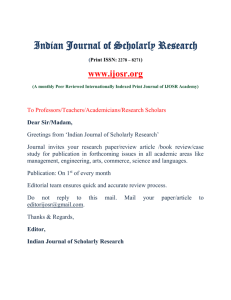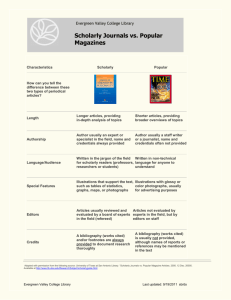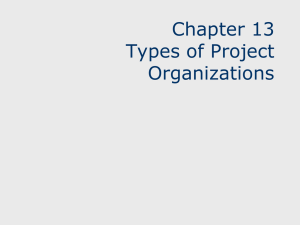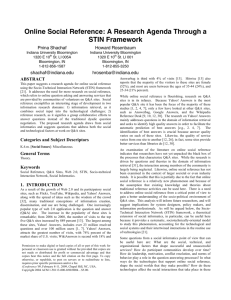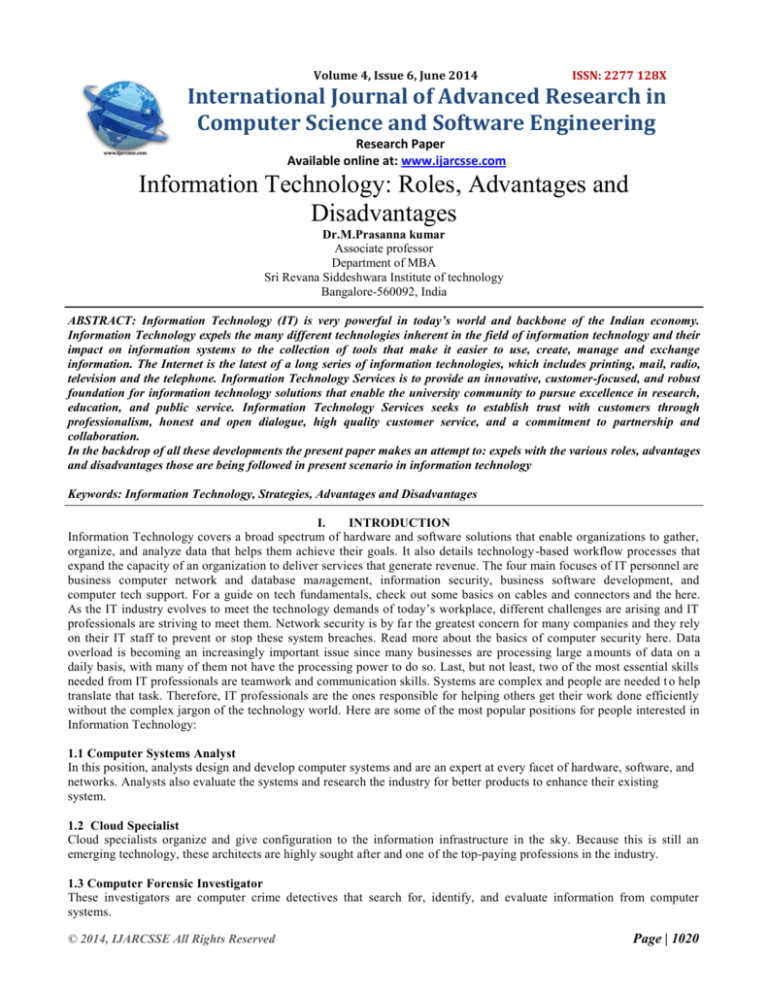
Volume 4, Issue 6, June 2014
ISSN: 2277 128X
International Journal of Advanced Research in
Computer Science and Software Engineering
Research Paper
Available online at: www.ijarcsse.com
Information Technology: Roles, Advantages and
Disadvantages
Dr.M.Prasanna kumar
Associate professor
Department of MBA
Sri Revana Siddeshwara Institute of technology
Bangalore-560092, India
ABSTRACT: Information Technology (IT) is very powerful in today’s world and backbone of the Indian economy.
Information Technology expels the many different technologies inherent in the field of information technology and their
impact on information systems to the collection of tools that make it easier to use, create, manage and exchange
information. The Internet is the latest of a long series of information technologies, which includes printing, mail, radio,
television and the telephone. Information Technology Services is to provide an innovative, customer-focused, and robust
foundation for information technology solutions that enable the university community to pursue excellence in research,
education, and public service. Information Technology Services seeks to establish trust with customers through
professionalism, honest and open dialogue, high quality customer service, and a commitment to partnership and
collaboration.
In the backdrop of all these developments the present paper makes an attempt to: expels with the various roles, advantages
and disadvantages those are being followed in present scenario in information technology
Keywords: Information Technology, Strategies, Advantages and Disadvantages
I.
INTRODUCTION
Information Technology covers a broad spectrum of hardware and software solutions that enable organizations to gather,
organize, and analyze data that helps them achieve their goals. It also details technology -based workflow processes that
expand the capacity of an organization to deliver services that generate revenue. The four main focuses of IT personnel are
business computer network and database management, information security, business software development, and
computer tech support. For a guide on tech fundamentals, check out some basics on cables and connectors and the here.
As the IT industry evolves to meet the technology demands of today’s workplace, different challenges are arising and IT
professionals are striving to meet them. Network security is by far the greatest concern for many companies and they rely
on their IT staff to prevent or stop these system breaches. Read more about the basics of computer security here. Data
overload is becoming an increasingly important issue since many businesses are processing large a mounts of data on a
daily basis, with many of them not have the processing power to do so. Last, but not least, two of the most essential skills
needed from IT professionals are teamwork and communication skills. Systems are complex and people are needed t o help
translate that task. Therefore, IT professionals are the ones responsible for helping others get their work done efficiently
without the complex jargon of the technology world. Here are some of the most popular positions for people interested in
Information Technology:
1.1 Computer Systems Analyst
In this position, analysts design and develop computer systems and are an expert at every facet of hardware, software, and
networks. Analysts also evaluate the systems and research the industry for better products to enhance their existing
system.
1.2 Cloud Specialist
Cloud specialists organize and give configuration to the information infrastructure in the sky. Because this is still an
emerging technology, these architects are highly sought after and one of the top-paying professions in the industry.
1.3 Computer Forensic Investigator
These investigators are computer crime detectives that search for, identify, and evaluate information from computer
systems.
© 2014, IJARCSSE All Rights Reserved
Page | 1020
Kumar, International Journal of Advanced Research in Computer Science and Software Engineering 4(6),
June - 2014, pp. 1020-1024
1.4 Health IT Specialist
Health IT is booming, especially with Affordable Care Act coming on and transition from paper to electronic health
records. Health IT specialists will mix computer knowledge will record-keeping skills, medical coding, and billing.
1.5 Database Administrator
Database administrators create, upgrade, and test for databases.
1.6 Web Developer
Web developers are in high demand because they have a great understanding of what makes a good operating system.
They create web pages, web applications and web content with their knowledge of what the average surfer finds visually
stimulating and how to optimize sites for mobile tech, among numerous other skills.
1.7 IT Manager
These managers are the contact pros when your email won’t send or Microsoft Word doesn’t open. As the head of the IT
department, they ensure that a company’s network is operating smoothly and that dangerous threats like malware are
minimized.
1.8 Information Technology Vendor Manager
Slightly more hands-off compared to some tech positions, vendor managers oversee supply when it comes to software and
hardware. This can mean anything from Microsoft’s latest word processor to health IT programs for hospitals.
1.9 Computer Systems Administrator
The expertise of network and computer systems administrators is essential to every office. Aside from maintaining a
healthy computer network, they also lend their tech knowledge to managing telecommunication networks. This profession
is expected to add 96,600 new positions by 2020!
1.10 Mobile Application Developer
Because of our highly-mobile lifestyle, mobile application developers are and will be in high demand for years to come,
especially as mobile devices and technology becomes increasingly sophisticated.
II.
DEFINATION OF INFORMATION TECHNOLOGY
Stands for "Information Technology," and is pronounced "I.T." It refers to anything related to computing technology, such as
networking, hardware, software, the Internet, or the people that work with these technologies. Many companies now have IT
departments for managing the computers, networks, and other technical areas of their businesses. IT jobs include computer
programming, network administration, computer engineering, Web development, technical support, and many other related
occupations. Since we live in the "information age," information technology has become a part of our everyday lives. That
means the term "IT," already highly overused, is here to stay.
III.
OBJECTIVES
To know the role of information technology
To understand the advantage and disadvantages in information technology.
IV.
METHODOLOGY
This study is based on the analysis of the secondary data published in the magazines and various websites.
V.
REVIEW OF LITERATURE
Scientists communicate to brainstorm ideas and be creative, formulate research questions, solve experimental or theoretical
problems, disseminate results, and get feedback. Several authors emphasize the importance of communication to science.
Garvey (1979)¹ states: “communication is the essence of science.” Abelson, an editor of the journal Science said, “Without
communication there would be no science” (1980, quoted in Lacy & Bush, 1983, p. 193) 2. The peer-reviewed journal article
– polished, archived, and findable – is only one facet of the scholarly communication process. Science is inherently social
and informal scholarly scientific communication forms the backbone that connects scientists and enables scientific progress.
Information and communication technologies have transformed our world in many ways; yet, informal scholarly scientific
communication forms a socio-technical interaction network in which communication is influenced by technology but
defined by the social structures of scientists and their organizations (Kling, McKim, & King, 2003 3; Lamb, Sawyer, & Kling,
2000)4. Researchers know a lot about informal scholarly scientific communication through a rich history of study of the
social structure of science and scholarly communication prior to the widespread availability of information and
communication technologies such as e-mail, the internet, and instant messaging. The purpose of this paper is review what we
© 2014, IJARCSSE All Rights Reserved
Page | 1021
Kumar, International Journal of Advanced Research in Computer Science and Software Engineering 4(6),
June - 2014, pp. 1020-1024
know about informal scholarly scientific communication and to examine exactly what influences information and
communication technologies have had on the existing structures. An understanding of this interaction of social structure and
media effects is important to better support the information seeking and communication of scientists.
1.
Garvey, W. D. (1979). Communication, the essence of science: Facilitating information exchange among librarians,
scientists, engineers, and students. New York: Pergamon Press.
2.
Lacy, W. B., & Busch, L. (1983). Informal scientific communication in the agricultural sciences. [Electronic
version]. Information Processing & Management, 19(4), 193-202.
3.
Kling, R., McKim, G., & King, A. (2003). A bit more to it: Scholarly communication forums as socio-technical
interaction networks. [Electronic version]. Journal of the American Society for Information Science and
Technology, 54(1), 47-67.
4.
Lamb, R., Sawyer, S., & Kling, R. (2000). A social informatics perspective on socio-technical networks. Paper
presented at the American Conference on Information Systems, Long Beach, CA, Retrieved April 8, 2006, from
http://lamb.cba.hawaii.edu/pubs/stnwtppr.htm.
VI.
ROLE OF INFORMATION TECHNOLOGY
Information technology (IT) has become a vital and integral part of every business plan. From multi-national corporations
who maintain mainframe systems and databases to small businesses that own a single computer, IT plays a role. The reasons
for the omnipresent use of computer technology in business can best be determined by looking at how it is being used across
the business world.
6.1 Communication
For many companies, email is the principal means of communication between employees, suppliers and customers. Email
was one of the early drivers of the Internet, providing a simple and inexpensive means to communicate. Over the years, a
number of other communications tools have also evolved, allowing staff to communicate using live chat systems, online
meeting tools and video-conferencing systems. Voice over internet protocol (VOIP) telephones and smart-phones offer even
more high-tech ways for employees to communicate.
6.2 Inventory Management
When it comes to managing inventory, organizations need to maintain enough stock to meet demand without investing in
more than they require. Inventory management systems track the quantity of each item a company maintains, triggering an
order of additional stock when the quantities fall below a pre-determined amount. These systems are best used when the
inventory management system is connected to the point-of-sale (POS) system. The POS system ensures that each time an
item is sold, one of that item is removed from the inventory count, creating a closed information loop between all
departments.
6.3 Data Management
The days of large file rooms, rows of filing cabinets and the mailing of documents is fading fast. Today, most companies
store digital versions of documents on servers and storage devices. These documents become instantly available to everyone
in the company, regardless of their geographical location. Companies are able to store and maintain a tremendous amount of
historical data economically, and employees benefit from immediate access to the documents they need.
6.4 Management Information Systems
Storing data is only a benefit if that data can be used effectively. Progressive companies use that data as part of their strategic
planning process as well as the tactical execution of that strategy. Management Information Systems (MIS) enable companies
to track sales data, expenses and productivity levels. The information can be used to track profitability over time, maximize
return on investment and identify areas of improvement. Managers can track sales on a daily basis, allowing them to
immediately react to lower-than-expected numbers by boosting employee productivity or reducing the cost of an item.
6.5 Customer Relationship Management
Companies are using IT to improve the way they design and manage customer relationships. Customer Relationship
Management (CRM) systems capture every interaction a company has with a customer, so that a more enriching experience
is possible. If a customer calls a call center with an issue, the customer support representative will be able to see what the
customer has purchased, view shipping information, call up the training manual for that item and effectively respond to the
issue. The entire interaction is stored in the CRM system, ready to be recalled if the customer calls again. The customer has a
better, more focused experience and the company benefits from improved productivity.
© 2014, IJARCSSE All Rights Reserved
Page | 1022
Kumar, International Journal of Advanced Research in Computer Science and Software Engineering 4(6),
June - 2014, pp. 1020-1024
VII.
ADVANTAGES AND DISADVANTAGES OF E-RETAILING
Management information systems are used by organizations to track, store, manipulate and distribute information to the
appropriate people when necessary. Using a management information system can enable a business to streamline its
operations into a cohesive functioning unit. Management information systems support business decision-making by providing
management with critical data. They serve to enhance the organization's communication, reduce human labor, support shortand long-term business goals and distribute complex information.
7.1 ADVANTAGES OF INFORMATION TECHNOLOGY
7.1.1 Globalization
IT has not only brought the world closer together, but it has allowed the world's economy to become a single interdependent
system. This means that we can not only share information quickly and efficiently, but we can also bring down barriers of
linguistic and geographic boundaries. The world has developed into a global village due to the help of information
technology allowing countries like Chile and Japan who are not only separated by distance but also by language to shares
ideas and information with each other.
7.1.2 Communication
With the help of information technology, communication has also become cheaper, quicker, and more efficient. We can now
communicate with anyone around the globe by simply text messaging them or sending them an email for an almost
instantaneous response. The internet has also opened up face to face direct communication from different parts of the world
thanks to the helps of video conferencing.
7.1.3 Cost effectiveness
Information technology has helped to computerize the business process thus streamlining businesses to make them extremely
cost effective money making machines. This in turn increases productivity which ultimately gives rise to profits that means
better pay and less strenuous working conditions.
7.1.4 Bridging the cultural gap
Information technology has helped to bridge the cultural gap by helping people from different cultures to communicate with
one another, and allow for the exchange of views and ideas, thus increasing awareness and reducing prejudice.
7.1.5 More time
IT has made it possible for businesses to be open 24 x7 all over the globe. This means that a business can be open anytime
anywhere, making purchases from different countries easier and more convenient. It also means that you can have your goods
delivered right to your doorstep with having to move a single muscle.
7.1.6 Creation of new jobs
Probably the best advantage of information technology is the creation of new and interesting jobs. Computer programmers,
Systems analyzers, Hardware and Software developers and Web designers are just some of the many new employment
opportunities created with the help of IT.
VIII.
DISADVANTAGES OF INFORMATION TECHNOLOGY
8.1Unemployment
While information technology may have streamlined the business process it has also created job redundancies, downsizing
and outsourcing. This means that a lot of lower and middle level jobs have been done away with causing more people to
become unemployed.
8.2 Privacy
Though information technology may have made communication quicker, easier and more convenient, it has also bought
along privacy issues. From cell phone signal interceptions to email hacking, people are now worried about their once private
information becoming public knowledge.
8.3 Lack of job security
Industry experts believe that the internet has made job security a big issue as since technology keeps on changing with each
day. This means that one has to be in a constant learning mode, if he or she wishes for their job to be secure.
8.4 Dominant culture
While information technology may have made the world a global village, it has also contributed to one culture dominating
another weaker one. For example it is now argued that US influences how most young teenagers all over the world now act,
© 2014, IJARCSSE All Rights Reserved
Page | 1023
Kumar, International Journal of Advanced Research in Computer Science and Software Engineering 4(6),
June - 2014, pp. 1020-1024
dress and behave. Languages too have become overshadowed, with English becoming the primary mode of communication
for business and everything else.
IX.
CONCLUSION
Information technology plays vital role in the world. Many changes have been occurring in society with the IT. There are
several things discuses to consider when information technology starts; this present paper makes an attempt to: deals with the
advantages and disadvantages of information technology and the essential roles that are being followed in present scenario in
information technology.
REFERENCE
1.
Garvey, W. D. (1979). Communication, the essence of science: Facilitating information exchange among librarians,
scientists, engineers, and students. New York: Pergamon Press.
Lacy, W. B., & Busch, L. (1983). Informal scientific communication in the agricultural sciences. [Electronic
version]. Information Processing & Management, 19(4), 193-202.
2.
Kling, R., McKim, G., & King, A. (2003). A bit more to it: Scholarly communication forums as socio-technical
interaction networks. [Electronic version]. Journal of the American Society for Information Science and
Technology, 54(1), 47-67.
3.
Lamb, R., Sawyer, S., & Kling, R. (2000). A social informatics perspective on socio-technical networks. Paper
presented at the American Conference on Information Systems, Long Beach, CA, Retrieved April 8, 2006, from
http://lamb.cba.hawaii.edu/pubs/stnwtppr.htm.
WEBSITES
A.
https://www.udemy.com/blog/introduction-to-information-technology/
B.
http://www.techterms.com/definition/it
C.
http://smallbusiness.chron.com/information-technology-its-role-modern-organization-1800.html
D.
https://in.answers.yahoo.com/question/index?qid=20101026165149AAB9bza
© 2014, IJARCSSE All Rights Reserved
Page | 1024




